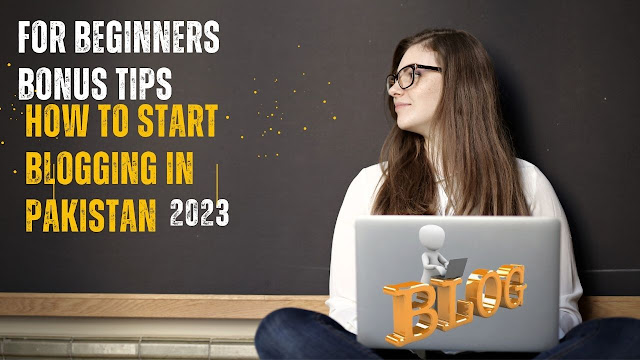If you want to start blogging, then you are thinking that you can earn a lot of money and build your career in it. Blogging is very advanced in 2023. So before you start blogging, you should also advance. It has to be .Everyone knows this, So in blogging first you need a website besides, you need hosting and domain to create a website
What is Hosting and Domain?
Hosting refers to where your website files and data are stored on a server. It's like a physical place to store your website data, and it allows people to access your website by visiting your domain name. Hosting providers can be large or small companies that manage servers and networks, offering different plans and prices depending on the size and complexity of the website and what you might expect.
In plain English, a domain name is the text that a user types into a browser window to reach a specific website. For example, Google's domain name is 'google.com
How to Create a Blogging Website
Choose a blogging platform: There are several popular blogging platforms available, such as WordPress, Blogger, and Squarespace. Each platform has its strengths and weaknesses, so you'll want to choose the one that best meets your needs.
Choose a domain name: Choose a domain name that is
memorable, easy to spell and reflects the content of your blog. Some platforms
like Blogger and Squarespace come with free subdomains, or you can buy your own
domain from a registrar like GoDaddy or Namecheap.
Choose a hosting provider: A hosting provider will store
your blog files and make it accessible to the world. Popular hosting providers
include Bluehost, SiteGround, and HostGator. Some platforms like WordPress.com
also provide hosting service.
Design and Customize Your Blog: Once your platform, domain,
and hosting are set up, you can start designing and customizing your blog. You
can choose from a number of templates, or create your own custom design. You can
also add functionality to your blog by installing plugins or widgets.
Create Content: Now that your blog is set up, you can start
creating and publishing content. Make sure your content is consistent and fits
the overall theme and tone of your blog.
Promote Your Blog: The last step is to promote your blog.
Share your new posts on social media, reach out to influencers, and consider
running ads to increase visibility. Engage with your audience and be open to
feedback.
Keep in mind that blogging takes time, effort and
consistency, it may take time for you to see significant results, but with hard
work and patience, you should be able to build a loyal following. will, and an
audience that can connect with your content.
What is Choose a Niche?
- Recipes and food
- Fashion
- Technology
- Education
- Home Decor
- Travel
- Health and Wellness
- Personal development and self-care
- Finance.
- Digital marketing
- Gaming
- Personal finance and investing
- Making money online.
- Parenting
- Affiliate marketing
- Marriage & Relationships
- Gardening
- Software
- Pet
- Sports
How to publish your first blog post?
- Click on the "Posts" menu in the left-hand sidebar, then select "Add New."
- In the editor, enter a title for your post in the "Enter title here" field.
- Write your post in the main editor. You can add text, images, videos, and other media to your post by using the buttons in the toolbar at the top of the editor.
- You can also use the "Add block" feature, in the top right corner, to add different types of content such as Gallery, List, Quote, and others.
- Once you have finished writing your post, you can preview it by clicking on the "Preview" button in the top-right corner of the screen.
- When you are satisfied with your post, you can publish it by clicking the "Publish" button on the top-right corner. You can choose to make it live immediately or schedule it for a later date and time.
- You can also adjust other settings for your post such as visibility settings, post format, categorization and tagging by clicking the settings button next to the publish button.
How do SEO my blog
- Identify keywords and phrases that your target audience is searching for and include them in your blog content and meta tags.
- Optimize your title tags and meta description: These tags appear in SERPs and accurately reflect the content of your blog post and contain the desired keywords.
- Optimize your images: Use descriptive, keyword-rich file names for your images and ALT tags.
- Improve your blog and design: Use a clean and simple design, create a logical and easy-to-use site structure, and make sure your blog is mobile-friendly.
- Create high-quality content: Make sure your blog post is well-researched, well-written, and provides value to your readers. Google favors content that is informative and engaging.
- Backlinks are linked to your blog from other websites. The more quality backlinks you have, the higher your blog will rank in the SERPs, so build backlinks.
- If you use WordPress, use the Yoast SEO plugin, it can help you optimize your on-page SEO and provide guidance on how to optimize your post for SEO.
- Use tools like Google Analytics and Google Search Console to track your blog's traffic and rankings, and adjust your strategy accordingly.
- Keep in mind that SEO is a long-term strategy, it takes time to see results, but with consistent efforts, you can improve your blog's visibility and drive more organic traffic to your website. It is also important to note that SEO is not limited to on-page optimization, social media plays a big role in your blog's SEO.
Bonus Tips to Start Blogging
Thankyou to read our blog post! We hope you
enjoyed our blog post.

